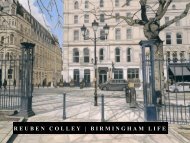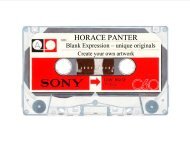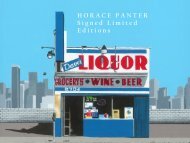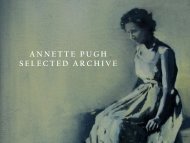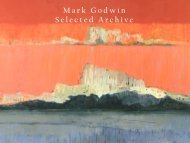Create successful ePaper yourself
Turn your PDF publications into a flip-book with our unique Google optimized e-Paper software.
<strong>Andy</strong> <strong>Warhol</strong><br />
From<br />
'<strong>Tat<strong>to</strong>oed</strong> <strong>Woman</strong><br />
Holding a Rose'<br />
(1955)<br />
<strong>to</strong><br />
'<strong>Lenin</strong>' (1987)<br />
January 14th – February 11th 2023
ANDY WARHOL<br />
<strong>Tat<strong>to</strong>oed</strong> <strong>Woman</strong> Holding a Rose<br />
1955<br />
74 x 28 cm<br />
Offset Lithograph on Onion Skin Paper<br />
Purchased directly <strong>from</strong> <strong>Andy</strong> <strong>Warhol</strong><br />
Foundation by Halcyon Gallery, London
ANDY WARHOL<br />
<strong>Tat<strong>to</strong>oed</strong> <strong>Woman</strong> Holding a Rose<br />
Before he became famous for his Pop Art imagery, <strong>Andy</strong> <strong>Warhol</strong> was a<br />
successful commercial artist.<br />
He created this image and hand printed it on<strong>to</strong> Japanese printmaking paper <strong>to</strong><br />
use as a calling card when he was looking for graphic design work.<br />
He would mail it <strong>to</strong> advertising firms rolled up like a scroll.<br />
The woman's skirt contains his phone number and her tat<strong>to</strong>os show many<br />
popular brands, some of which will show up later in <strong>Warhol</strong>’s iconic Pop Art<br />
pieces.
ANDY WARHOL<br />
In the Bot<strong>to</strong>m of My Garden (F&S 86A-<br />
105A)<br />
Bound Hand Coloured Book containing<br />
21 lithographs<br />
1956<br />
28 x 22 cm<br />
21 Offset Lithographs<br />
11 with hand colouring in Dr. Martin’s<br />
Aniline Ink<br />
CLICK HERE TO VIEW THE BOOK<br />
Authenticated and stamped by the <strong>Andy</strong><br />
<strong>Warhol</strong> Foundation<br />
From an unknown edition
ANDY WARHOL<br />
In the Bot<strong>to</strong>m of My Garden<br />
Rare example of the complete book in excellent condition<br />
<strong>Andy</strong> <strong>Warhol</strong>’s illustrated book of fairies and putti frolicking in a garden was one of his<br />
several forays in<strong>to</strong> bookmaking with offset lithography in the 1950s, with colouring done by<br />
hand by <strong>Warhol</strong> and his friends<br />
In the Bot<strong>to</strong>m of My Garden by <strong>Andy</strong> <strong>Warhol</strong> incorporates both his commercial art<br />
background and style with his budding fine art and Pop art career. The book combines his<br />
blotted line technique and it has a playful nature <strong>to</strong> it. Like in many of <strong>Warhol</strong>’s other paper<br />
works, his mother, Julia <strong>Warhol</strong>a’s writes the text for the images. The overly decorated<br />
cursive, is then combined with what would end up being themes in his later pop work –<br />
androgynous “fairies,” flowers, and of course sex. Each image <strong>from</strong> In the Bot<strong>to</strong>m of my<br />
Garden is peopled with dumpy little putti frolicking amongst flowers, and it is probably the<br />
nearest <strong>Warhol</strong> got <strong>to</strong> whimsy, however on close inspection there is an underlying naughty<br />
sexiness <strong>to</strong> the prancing!<br />
Most of the pictures are hand coloured with <strong>to</strong>uches of fluorescent pink, orange, blue and<br />
green watercolour, while others are just as pretty but in black and white. These early images<br />
incorporate <strong>Warhol</strong>’s trademark irregular blotted lines and flat use of colour, which he learnt<br />
at college while training as a commercial artist. One could say that these putti mark the<br />
beginning of the artist’s artistic metamorphosis.
ANDY WARHOL<br />
Toma<strong>to</strong> Soup (F&S II. 46)<br />
1968<br />
58 x 90 cm<br />
Silkscreen on Paper<br />
Signed by <strong>Andy</strong> <strong>Warhol</strong><br />
From the edition of 250
ANDY WARHOL<br />
Toma<strong>to</strong> Soup<br />
Campbell’s Soup Cans I: Toma<strong>to</strong> by <strong>Andy</strong> <strong>Warhol</strong> is a print <strong>from</strong> his 1968 Campbell’s Soup Cans I portfolio. It is also the<br />
most collectable of the Soup Cans. The famous series exhibits <strong>Warhol</strong>’s ability <strong>to</strong> break the mold of his time and<br />
champion the Pop Art movement. After painting 32 Campbell’s Soup Cans in 1962, <strong>Warhol</strong> returned <strong>to</strong> the soup can<br />
concept <strong>to</strong> screen print the images. Using this technique, he was able <strong>to</strong> achieve an even closer replication <strong>to</strong> the actual<br />
Campbell’s product. The design is simple and bold, and uses a small range of colours <strong>to</strong> create a pleasant contrast. Out<br />
of all the different soup flavours <strong>Warhol</strong> created, the <strong>to</strong>ma<strong>to</strong> flavour is perhaps the most famous. This portfolio, as well<br />
as Campbell’s Soup Cans II (1969), contain some of <strong>Warhol</strong>’s most valuable screen prints.<br />
When viewing works like Campbell’s Soup Cans I: Toma<strong>to</strong> it becomes evident why <strong>Warhol</strong>’s works were so difficult for<br />
some audiences <strong>to</strong> digest. Popular artwork of the time focused on abstract composition, and the artist’s ability <strong>to</strong><br />
convey emotion through the canvas. Clearly, <strong>Warhol</strong>’s soup cans are not meant <strong>to</strong> be admired as a feat of technical skill,<br />
or as a masterful showcase of painterly accomplishment. Instead, <strong>Warhol</strong>’s Campbell’s Soup cans are rich in a<br />
conceptual sense. The significance of the work is linked closely with <strong>Warhol</strong>’s his<strong>to</strong>rical circumstance and the timing of<br />
publication. Moreover, they are illustrative of <strong>Warhol</strong>’s philosophy as an artist.<br />
In addition <strong>to</strong> being the most iconic representations of <strong>Warhol</strong>’s signature style, the Campbell’s Soup cans challenged<br />
established norms of artistic value. With the soup cans, <strong>Warhol</strong> experimented with the context of art, and pushed the<br />
limits of what society might accept as art. For instance, if you see a Campbell’s Soup can on a billboard, you probably<br />
wouldn’t consider it as art, but as a mundane advertisement. However, by recreating the same image and placing it in a<br />
gallery, <strong>Warhol</strong> urges us <strong>to</strong> pay closer attention.<br />
Thus, with his early pop art creations like Toma<strong>to</strong> Soup, <strong>Warhol</strong> encourages us <strong>to</strong> view certain images differently, and<br />
<strong>to</strong> reconsider our ideas of what “counts” as art. The soups thus attain a provocative quality, especially considering the<br />
his<strong>to</strong>rical moment <strong>from</strong> which they originated. Overall, <strong>Warhol</strong>’s Campbell’s Soup cans redirected common views of<br />
artistic merit, and challenged accepted norms of the art world. Campbell’s Soup I: Toma<strong>to</strong> helped popularise the Pop<br />
Art genre and stands as a masterpiece of modern art.
ANDY WARHOL<br />
Green Pea Soup (F&S II. 50)<br />
1968<br />
58 x 90 cm<br />
Silkscreen on Paper<br />
Signed by <strong>Andy</strong> <strong>Warhol</strong><br />
From the edition of 250
ANDY WARHOL<br />
Green Pea Soup<br />
Campbell’s Soup Cans I: Green Pea is heavy with <strong>Andy</strong> <strong>Warhol</strong>’s<br />
fascinations and philosophy.<br />
<strong>Warhol</strong>’s inspiration <strong>to</strong> paint and screen print the Campbell’s Soup<br />
cans has <strong>to</strong> do with his fascination for simple commodities, and the<br />
fact that he claimed <strong>to</strong> drink Campbell’s Soup almost everyday for<br />
20 years.<br />
He had a very positive view of capitalism and consumer culture.<br />
<strong>Warhol</strong> thought that products like Campbell’s Soup cans, Coke, or<br />
Life Savers, were amazing miracles of modern society.
ANDY WARHOL<br />
Electric Chair (F&S II.77)<br />
1971<br />
122 x 90 cm<br />
Silkscreen on Paper<br />
Signed by <strong>Andy</strong> <strong>Warhol</strong><br />
From the edition of 250
ANDY WARHOL<br />
Electric Chair<br />
<strong>Andy</strong> <strong>Warhol</strong> was preoccupied with news reports of violent death—suicides,<br />
car crashes, assassinations, and executions.<br />
In the early 1960s he began <strong>to</strong> make paintings, such as Orange Disaster #5<br />
(1963), with the serial application of images revolving around the theme of<br />
death; this reiteration of the macabre also became the subject of print<br />
portfolios, as in Electric Chair (1971).<br />
“When you see a gruesome picture over and over again,” he commented, “it<br />
doesn’t really have any effect.” Yet Electric Chair, with its eponymous chair<br />
printed once on each of ten separate sheets of paper, belies this statement. The<br />
work speaks <strong>to</strong> the constant reiteration of tragedy in the media, and becomes,<br />
perhaps, an attempt <strong>to</strong> exorcise this image of death through repetition.<br />
However, it also emphasizes the pathos of the empty chair waiting for its next<br />
victim, the jarring array of colours only accentuating the horror of the isolated,<br />
expectant seat.
ANDY WARHOL<br />
Sunset (F&S II. 85-89)<br />
This is a unique work<br />
every print was coloured differently<br />
1972<br />
86 x 86 cm<br />
Silkscreen on paper<br />
Signed by <strong>Andy</strong> <strong>Warhol</strong><br />
From and edition of 40 (each unique)
ANDY WARHOL<br />
Sunset<br />
<strong>Andy</strong> <strong>Warhol</strong>’s Sunset series was produced in 1972, commissioned by renowned architects<br />
Johnson & Burgee <strong>to</strong> be installed in their newly renovated Hotel Marquette in Minneapolis,<br />
Minnesota.<br />
The series consisted of 472 unique colour variations for installation in the hotel, in addition<br />
<strong>to</strong> 160 prints that were assembled in <strong>to</strong> 40 unique portfolios.<br />
We have one of the Hotel pieces (stamped on verso with Hotel Marquette) and also this<br />
piece <strong>from</strong> the edition of 40.<br />
As<strong>to</strong>nishingly, all of the Sunset prints were produced using only three screen prints: one <strong>to</strong><br />
apply the background strips of colour, one for the sun and one with a single-colour dot<br />
pattern <strong>to</strong> provide texture. <strong>Warhol</strong> then inked the screens in a range of colour combinations<br />
and printed them with varying registration <strong>to</strong> create a <strong>to</strong>tal of 632 unique screen prints on<br />
smooth woven paper.<br />
<strong>Warhol</strong> sought <strong>to</strong> comment on American capitalism whist creating some of the most iconic<br />
and enduring images in the his<strong>to</strong>ry of Pop Art.<br />
However, the Sunset series, which is revered as one of the most expressive portfolios of<br />
<strong>Warhol</strong>’s career, strays away <strong>from</strong> the terri<strong>to</strong>ry of celebrity culture.
ANDY WARHOL<br />
Sunset (F&S II. 85-88)<br />
Hotel Maquette – unique<br />
This is a unique work<br />
every print was coloured differently<br />
1972<br />
87 x 87 cm<br />
Silkscreen on Paper<br />
Signed by <strong>Andy</strong> <strong>Warhol</strong><br />
Hotel Maquette stamp on verso<br />
From an edition of 470 (each unique)
ANDY WARHOL<br />
Sunset (Hotel Maquette)<br />
<strong>Andy</strong> <strong>Warhol</strong>’s Sunset (Green/Red/Green), created in 1972, is a screen-print based off of<br />
several reels of sunset pho<strong>to</strong>graphs shot in East Hamp<strong>to</strong>n, San Francisco, and New York.<br />
<strong>Warhol</strong>’s film is called Sunset, and it is one of the fifty films that has been preserved by the<br />
Museum of Modern Art.<br />
Each sunset image contains different colours thus evoking a different sensation based upon the<br />
colours. This particular Sunset screen print depicts a red sun with a graduated green<br />
background. Each print in the Sunset portfolio is unique, as they are all based off of different<br />
stills <strong>from</strong> Sunset.<br />
472 unique Sunset prints were used by architects Johnson & Burgee for the Hotel Marquette,<br />
Minneapolis, Minnesota. In 1981 when the hotel was renovated, these prints were removed,<br />
signed, numbered 1/470 – 470/470, and dated in pencil on verso, and two were marked “HC”.<br />
They were also stamped in black on verso “Hotel Marquette Prints.”<br />
The Sunset series was produced in 1972 on smooth wove paper. This series is an extreme<br />
example of the concept of colour serialization. The screen-print was produced at an unheard of<br />
472 unique colour variations with the use of only three screens. The sunset series is considered<br />
<strong>to</strong> be one of <strong>Warhol</strong>’s more expressive projects he produced in his lifetime
ANDY WARHOL<br />
Washing<strong>to</strong>n Monument (F&S IIIB. 2)<br />
1974<br />
111 x 75 cm<br />
Silkscreen on Wallpaper<br />
Estate Stamped<br />
<strong>from</strong> an unknown edition<br />
Directly <strong>from</strong> <strong>Andy</strong> <strong>Warhol</strong> Foundation
ANDY WARHOL<br />
Washing<strong>to</strong>n Monument<br />
<strong>Andy</strong> <strong>Warhol</strong> was a pioneer in the creation of artistic wallpapers and produced eight<br />
wallpapers during his career, with the Cow pieces being the best know.<br />
<strong>Warhol</strong> had found the subject of the cow in a book on agriculture. The bibliographical<br />
source of the original black and white picture of the cow that he had used, which he<br />
detached <strong>from</strong> the page, is still unknown <strong>to</strong> this day.<br />
<strong>Warhol</strong>’s first three uses of wallpaper were primarily aimed at creating a space, an<br />
installation in short, without any work hanging on the wallpaper. <strong>Warhol</strong>’s idea <strong>to</strong>ok a<br />
decisive turn five years later, (an idea that he would retain for the rest of his career) when<br />
he imagined wallpaper as a background for his paintings.<br />
<strong>Warhol</strong>’s wallpapers are always consistent in terms of the motifs represented, namely the<br />
multiplication of subjects imitating their multiple state in real life. Such as the many cows<br />
that make up a herd on a farm, <strong>Warhol</strong> respects this co-existent seriality with the very<br />
nature of the subject or object.<br />
Only one wallpaper created in 1974 by the artist escapes this observation: representing<br />
the American capital’s monument, Washing<strong>to</strong>n Monument’s origin and destination<br />
remain unknown <strong>to</strong> this day, having never been used for an exhibition during the artist’s<br />
lifetime.
ANDY WARHOL<br />
Mick Jagger (F&S II.144)<br />
1975<br />
74 x 110 cm<br />
Silkscreen on Arches Aquarelle<br />
Signed by <strong>Andy</strong> <strong>Warhol</strong> and Mick Jagger<br />
From an edition of 250
ANDY WARHOL<br />
Mick Jagger<br />
<strong>Andy</strong> <strong>Warhol</strong> and Mick Jagger met at a party in 1964 when the Rolling S<strong>to</strong>nes were on their first US <strong>to</strong>ur.<br />
At this time both were rising <strong>to</strong> fame and establishing their image. The Rolling S<strong>to</strong>nes were viewed as<br />
the dirty alternative <strong>to</strong> the clean cut Beatles and art collec<strong>to</strong>rs may have viewed <strong>Andy</strong> <strong>Warhol</strong> in a<br />
similar way compared <strong>to</strong> other artists at the time such as Jasper Johns and Tom Wesselmann. Their<br />
relationships grew over the years and they attended many lavish rock star parties <strong>to</strong>gether.<br />
In the summer of 1975 whilst Mick and his wife Bianca were staying at<br />
<strong>Andy</strong>’s house in Mautauk, <strong>Andy</strong> <strong>to</strong>ok pho<strong>to</strong>graphs of Mick all of which<br />
were head and bare-chested shots, <strong>Andy</strong> wanted <strong>to</strong> capture different<br />
emotions with Jagger playing up <strong>to</strong> the camera, he particularly liked<br />
Jagger’s pho<strong>to</strong>genic ‘Bad-boy’ image.<br />
Back in the studio <strong>Andy</strong> created a series of 10 portraits of Mick Jagger as<br />
screen prints using the pho<strong>to</strong>graphs he had taken. He added hand drawn<br />
stylized lines and incorporated blocks of irregularly shaped colour, which<br />
although printed, appear like collaged fragments of coloured paper.<br />
These works were more expressive than his earlier screen-prints and the<br />
abstract quality of the blocks of colour show the development of<br />
<strong>Warhol</strong>'s interest in more non-representational art that was emerging in<br />
the 1970’s.<br />
These pieces are rare as they feature not only the signature of the artist, but also that of the sitter.<br />
Also, very few of the subjects of <strong>Warhol</strong>’s works are still living.
ANDY WARHOL<br />
After the Party (F&S II.183)<br />
Rare signed version<br />
1979<br />
77 x 55 cm<br />
Silkscreen on Arches 88 Paper<br />
Signed by <strong>Andy</strong> <strong>Warhol</strong><br />
From an edition of 1000<br />
(only a small number of this edition were<br />
signed)
ANDY WARHOL<br />
After the Party<br />
After the Party is a black and white pho<strong>to</strong> of a table with scattered glasses and plates, brought <strong>to</strong> life<br />
by the rainbow gradient highlighting the subjects.<br />
There is an inherent chaos in the work, a feeling of excess, in part due <strong>to</strong> the reflective quality and<br />
haphazard arrangement of the glasses, the bright hues that outline the items, and the manner in<br />
which the print was created and aligned.<br />
The print evokes ideas of gilded wealth and excess and their perceived glory, hiding a plainness and<br />
darkness behind them. Each print of After the Party has a unique colourful outlining around the<br />
objects in the work, making no two prints completely alike.<br />
The subject and the print itself suggest the residue of a frenzied yet enjoyable gathering through both<br />
compositional arrangement and artistic liberties taken by <strong>Warhol</strong> in the creation of this print. “The<br />
best kind of party I could give would be champagne and nuts and then take everybody dancing” (The<br />
Philosophy of <strong>Andy</strong> <strong>Warhol</strong>: From A <strong>to</strong> B and Back Again p. 196).<br />
Only a small amount of the edition of 1000 were signed by <strong>Andy</strong> <strong>Warhol</strong> – the rest were Estate<br />
Stamped.
ANDY WARHOL<br />
After the Party (AGFA)<br />
Unique aside <strong>from</strong> the edition<br />
1979<br />
85 x 60 cm<br />
Three Screen-prints in colours on Vinyl<br />
Estate Stamped<br />
Unique aside<br />
Coming directly <strong>from</strong> <strong>Andy</strong> <strong>Warhol</strong><br />
Foundation in early 2023<br />
Better image coming soon once piece arrives in UK
ANDY WARHOL<br />
After the Party (AGFA)<br />
This version of After the Party is a unique original piece on Vinyl that is an aside <strong>from</strong> the<br />
edition.<br />
Printed on three separate pieces of orange vinyl and collaged <strong>to</strong>gether on paper, this is a very<br />
special pieces for any collec<strong>to</strong>r.<br />
After the Party (AGFA) comes directly <strong>from</strong> the <strong>Andy</strong> <strong>Warhol</strong> Foundation, and has the<br />
foundation stamp on the verso with unique code.
ANDY WARHOL<br />
Beatles (F&S IIIB.5 a)<br />
Unique Silkscreen<br />
1980<br />
102 x 61 cm<br />
Silkscreen on Lennox Museum Board<br />
Estate Stamped<br />
Unique commissioned work
ANDY WARHOL<br />
The Beatles<br />
Original Book Cover made using the same screens<br />
Based on a pho<strong>to</strong>graph by Dezo Hoffmann, London, England. Created for the jacket of the 1980 book<br />
'The Beatles' published by Rolling S<strong>to</strong>ne Press Books / Times Books,<br />
the same year John Lennon was senselessly murdered.<br />
<strong>Andy</strong> <strong>Warhol</strong> trialled several variations before selecting the image finally used as the cover.<br />
A small number of these were created using silkscreen on collaged paper.<br />
This is one of those rare unique collages.<br />
Complete with full provenance <strong>from</strong> the Estate of <strong>Andy</strong> <strong>Warhol</strong>.
ANDY WARHOL<br />
Mildred Scheel (Double) (F&S IIB. 239)<br />
Unique AP<br />
1980<br />
109 x 78 cm<br />
Silkscreen with diamond dust<br />
on Arches 88 Paper<br />
Signed by <strong>Andy</strong> <strong>Warhol</strong><br />
Artist Proof – each is unique<br />
Coming directly <strong>from</strong> <strong>Andy</strong> <strong>Warhol</strong><br />
Foundation in early 2023<br />
Better image coming soon once piece arrives in UK
ANDY WARHOL<br />
Mildred Scheel<br />
Mildred Scheel was published <strong>to</strong> raise funds for the German Cancer Society (Deutsche Krebshilfe),<br />
which Scheel founded in 1974.<br />
Scheel was admired by many for her philanthropic activism and was nominated as Germany’s<br />
“<strong>Woman</strong> of the Year” in 1977, 1978 and 1979.<br />
In 1980, <strong>Andy</strong> <strong>Warhol</strong>, Scheel’s long-time friend, immortalized her in this beautiful limited edition<br />
double image screen-print.<br />
This print of Mildred Scheel is one of the two prints that <strong>Warhol</strong> made of the famous philanthropist.<br />
Though they are both based off of the same image, this print copies the portrait of Scheel and adds<br />
more colour blocked layering. Each print is unique in its colourway.<br />
Mildred Scheel was a German doc<strong>to</strong>r and the second wife of former German president Walter Scheel.<br />
Scheel devoted her life <strong>to</strong> the fight against cancer, but died <strong>from</strong> the disease in 1985.<br />
This print is especially vibrant, which is creatively juxtaposed with the professional pho<strong>to</strong> and poised<br />
expression of Scheel. This portrait is a great departure <strong>from</strong> the ostentatiously glamorous portraits of<br />
Liz Taylor and Marilyn Monroe.<br />
This work has come directly <strong>from</strong> the <strong>Andy</strong> <strong>Warhol</strong> Foundation.
ANDY WARHOL<br />
Edward Kennedy (F&S IIB. 240)<br />
Unique<br />
1980<br />
81 x 102 cm<br />
Silkscreen with diamond dust on Lennox<br />
Museum Board<br />
Signed by <strong>Andy</strong> <strong>Warhol</strong><br />
Trial Proof of 15 - each unique<br />
Coming directly <strong>from</strong> <strong>Andy</strong> <strong>Warhol</strong><br />
Foundation in early 2023<br />
Better image coming soon once piece arrives in UK
ANDY WARHOL<br />
Edward Kennedy (Trial Proof)<br />
Edward Kennedy by <strong>Andy</strong> <strong>Warhol</strong> is a print produced <strong>to</strong> raise funds for Kennedy’s 1980<br />
Presidential campaign.<br />
<strong>Andy</strong> <strong>Warhol</strong>'s silkscreened portrait plays off the colours of the American flag and suggests the<br />
glamour of politics by enhancing the candidate's features with red and blue diamond dust.<br />
This work is rare because it was a small edition originally intended only for donors of Kennedy’s<br />
campaign. <strong>Warhol</strong> was vastly interested in political figures, with his prints such as Mao, Vladimir<br />
<strong>Lenin</strong> and Alexander the Great. However, he was doubly interested in the Kennedy family.<br />
In addition <strong>to</strong> the Edward Kennedy set, <strong>Warhol</strong> produced Flash, a portfolio of the death of John F.<br />
Kennedy, and a Jacqueline (Jackie) Kennedy portfolio.<br />
Although Kennedy didn’t go on <strong>to</strong> win the Democratic nomination, he continued <strong>to</strong> pursue politics<br />
and became known as the “Lion of the Senate.” While in office, Kennedy wrote hundreds of bills that<br />
were passed and enacted in<strong>to</strong> law. The image of Kennedy comes <strong>from</strong> a Polaroid taken by <strong>Warhol</strong>.<br />
We have two unique pieces in this collection, one a signed Trial Proof and the other an aside <strong>from</strong><br />
the edition with Estate Stamps.<br />
Both pieces have come directly <strong>from</strong> the <strong>Andy</strong> <strong>Warhol</strong> Foundation.
ANDY WARHOL<br />
Edward Kennedy (Aside)<br />
Unique Aside<br />
1980<br />
81 x 102 cm<br />
Silkscreen with diamond dust<br />
on Lennox Museum Board<br />
Estate Stamped<br />
Unique Screen-print – aside <strong>from</strong> edition<br />
Coming directly <strong>from</strong> <strong>Andy</strong> <strong>Warhol</strong><br />
Foundation in early 2023<br />
Better image coming soon once piece arrives in UK
ANDY WARHOL<br />
Edward Kennedy (Unique Aside)<br />
Elected <strong>to</strong> the United States Senate in 1962, Edward Kennedy owed his early success <strong>to</strong> his close<br />
identification with his elder brothers, President John F. Kennedy, whose Senate term he completed, and<br />
At<strong>to</strong>rney General Robert F. Kennedy. Praising their commitment <strong>to</strong> public service, he acknowledged, "I'm<br />
very proud of that association."<br />
Kennedy built on this legacy when he sought the presidency in 1980.<br />
<strong>Andy</strong> <strong>Warhol</strong>'s silkscreened portrait, created as a campaign fund-raiser, plays off the colours of the<br />
American flag with each piece being unique. <strong>Warhol</strong>’s portrait of Kennedy is now on display at the<br />
National Portrait Gallery, at The Smithsonian on the museum’s first floor.<br />
Although Kennedy lost the 1980 Democratic nomination <strong>to</strong> Jimmy Carter, whom <strong>Warhol</strong> had portrayed<br />
four years earlier, the long-serving sena<strong>to</strong>r became an influential leader in his party, addressing such<br />
issues as health care, education, and immigration reform.<br />
This copy is an aside <strong>from</strong> the edition using heavy diamond dust in red and blue.<br />
Complete with stamps on the verso <strong>from</strong> The <strong>Andy</strong> <strong>Warhol</strong> Foundation.<br />
Both ‘Edward Kennedy’ pieces have come directly <strong>from</strong> the <strong>Andy</strong> <strong>Warhol</strong> Foundation.
ANDY WARHOL<br />
$ Unique<br />
Rare Original Painting on Canvas<br />
1981<br />
40 x 50cm<br />
Original Synthetic Polymer Paint and<br />
Silkscreen Ink on Canvas<br />
Estate Stamped<br />
As featured in an exhibitions of original $’s at<br />
Gagosian Gallery, California in 1997<br />
Available <strong>to</strong> view by private appointment<br />
only
ANDY WARHOL<br />
$ - Dollar original<br />
The Dollar Signs are among <strong>Andy</strong> <strong>Warhol</strong>'s most powerful and essential images, perhaps equal <strong>to</strong><br />
the his<strong>to</strong>ric Campbell's Soup Cans of 1962, in their brash reinvention of what is allowed in a work<br />
of art. In the Dollar Signs, <strong>Warhol</strong> unabashedly said that "big-time art is big-time money" and, with<br />
his brutal truthfulness, bluntly printed the sign for money as the sign for art.<br />
On the other hand, given their wild colour and flamboyant drawing and design, the Dollar Signs are<br />
"artistic" in the extreme. Like his greatest works, they empty and glamorize in one stroke, making<br />
the object blank and banal, yet lyrical and deliciously seductive. Recall the famous Marilyn's <strong>from</strong><br />
1962, where he screened the image of the dead movie star on candy coloured backgrounds and<br />
titled the series The Flavors. The Dollar Signs exhibit the same panoramic understanding of the<br />
commodity, in all its crassness and allure, but focus even tighter upon its essence: money.<br />
The Dollar Signs are signature works in the extreme – the signature for cash, for art, and for<br />
<strong>Warhol</strong>, himself. They also epi<strong>to</strong>mize his deadpan genius for truth-telling and sizing-up the future.<br />
When he completed the Dollar Signs in 1981, the worlds of art and business had just begun a<br />
his<strong>to</strong>rically money-mad decade. The pertinence, originality, and affront of these paintings are even<br />
more alive <strong>to</strong>day, as the nations of the planet combine in<strong>to</strong> the biggest commodity trading floor<br />
mankind has ever known.<br />
This amazing original work on canvas was featured in a major Gagosian Exhibition in 1997<br />
Click here <strong>to</strong> read the original press release.
ANDY WARHOL<br />
Superman (F&S II.260)<br />
1981<br />
97 x 97 cm<br />
Silkscreen with Diamond Dust on Lenox<br />
Museum Board<br />
Signed by <strong>Andy</strong> <strong>Warhol</strong><br />
From and edition of 200
ANDY WARHOL<br />
Superman (<strong>from</strong> ‘Myths’ portfolio)<br />
Prints <strong>from</strong> the Myths collection re-situate our perception of 20th century cultural trends, while<br />
also placing the enigmatic artist in a more vulnerable light. Each print is said <strong>to</strong> reveal distinct<br />
facets of <strong>Warhol</strong>’s personality.<br />
At eight years old, <strong>Andy</strong> <strong>Warhol</strong> found a new idol: Superman.<br />
Diagnosed with an au<strong>to</strong>immune disease, the young artist was bedridden for months after episodes<br />
of involuntary shaking led <strong>to</strong> bullying at school.<br />
At home, <strong>Warhol</strong> escaped in<strong>to</strong> the world of comic books, especially the tale of Clark Kent.<br />
As an insecure young boy, <strong>Warhol</strong> found hope in Kent’s transformation <strong>from</strong> underdog <strong>to</strong><br />
superhero.<br />
Superman has become a universal symbol for goodness, truth, justice, and hope. He is the<br />
embodiment of the perfect flawless male, <strong>from</strong> his chiselled physique <strong>to</strong> his meticulously gelled<br />
forehead curl. Like many children, <strong>Warhol</strong> imagined himself in the shoes of his favourite comic<br />
book heroes, scaling buildings, shooting webs, and defending mankind against all manner of<br />
threats. While <strong>Warhol</strong>’s Superman depicts a larger-than-life hero, it also humanizes the artist,<br />
reminding us of the difficulties he faced throughout his life.
ANDY WARHOL<br />
Howdy Doody (F&S II.263)<br />
1981<br />
97 x 97 cm<br />
Silkscreen with Diamond Dust on Lenox<br />
Museum Board<br />
Signed by <strong>Andy</strong> <strong>Warhol</strong><br />
From an edition of 200
ANDY WARHOL<br />
Howdy Doody (<strong>from</strong> ‘Myths’ portfolio)<br />
<strong>Andy</strong> <strong>Warhol</strong> regarded celebrity culture as the height of modern consumerism.<br />
He had been drawn <strong>to</strong> the representation of public figures all his life, and created portraits of everyone <strong>from</strong><br />
Marilyn Monroe <strong>to</strong> <strong>Lenin</strong>. Aware of the power and ubiquity of his prolific subjects, <strong>Warhol</strong>’s perception of<br />
celebrity only bloomed as he broadened his scope <strong>to</strong> include politicians, athletes, and even fictional characters<br />
and his career unfolded.<br />
Howdy Doody depicts a blue-eyed boy with prominent red hair, a gap-<strong>to</strong>oth grin, pronounced ears, and<br />
freckled cheeks. The boy’s comically large head and hands occupy one-half of the frame. He beams happily as<br />
he waves at the viewer. Dressed like a western-style cowboy, he sports a bright red bandana, checked blue<br />
flannel, and yellow gloves. <strong>Warhol</strong> highlights these primary colours, setting the boy on a plain grey<br />
background and tracing over him with a subtle pink-purple gradient, a technique he employed often <strong>to</strong><br />
accentuate his subjects (as can be seen in series like Reigning Queens and Endangered Species series). The<br />
print is inlaid with “diamond dust:” crushed up pieces of glass that catches light and creates threedimensional<br />
depth.<br />
It is said that each character in the Myths series reveals specific facets of <strong>Warhol</strong>’s personality. Though <strong>Warhol</strong><br />
never stated his reasons for including Howdy Doody in the series, the print demonstrates his aptness for<br />
recognizing what appealed <strong>to</strong> the fame-hungry masses. Howdy Doody possesses a strange sense of<br />
insentience reflected in his animated smile and exaggerated features. That is because he is not a boy but a<br />
marionette, the star of The Howdy Doody Show, a popular children’s program which aired on NBC <strong>from</strong> 1947<br />
<strong>to</strong> 1960. The show’s host, former radio personality Robert E. Smith, nicknamed Buffalo Bob, invented the<br />
marionette character and performed his voice on television. He made an indelible impression on American<br />
audiences, garnering mass attention and popularity and a devoted fanbase.
ANDY WARHOL<br />
$ (F&S II, 277)<br />
Unique<br />
1982<br />
40 x 50cm<br />
Silkscreen on Lennox Museum Board<br />
Signed by <strong>Andy</strong> <strong>Warhol</strong><br />
From and edition of 60<br />
Each silkscreen in this edition is a unique<br />
colourway.
ANDY WARHOL<br />
$ - Dollar screen-print<br />
Although the design in Dollar Sign 277 is relatively simple, the use of complementary colours<br />
makes for an exciting composition. The entire series includes multiple variations, printed on Lenox<br />
Museum Board in a variety of bold unique colours.<br />
This series represents <strong>Andy</strong> <strong>Warhol</strong>’s fascination with money and fortune. He once wrote in The<br />
Philosophy of <strong>Andy</strong> <strong>Warhol</strong>, “I like money on the wall. Say you were going <strong>to</strong> buy a $200,000<br />
painting. I think you should take that money, tie it up, and hang it on the wall. Then when someone<br />
visited you the first thing they would see is the money on the wall.” By creating his Dollar Sign<br />
portfolio, <strong>Warhol</strong> quite literally put money on the wall, welcoming the viewer <strong>to</strong> ponder the allencompassing<br />
power of his pop-art.<br />
<strong>Warhol</strong> is famous for his attraction <strong>to</strong> consumer culture and capitalism, and both are recurring<br />
themes in his body of work. <strong>Warhol</strong> even dubbed his studio “The Fac<strong>to</strong>ry,” seeking <strong>to</strong> create art in<br />
an almost assembly line style. Inspired by the manufacturing methods of the post-war era, he<br />
sought <strong>to</strong> reach an unprecedented level of artistic output. The Dollar Sign series strongly<br />
encapsulates <strong>Warhol</strong>’s fascination for money and commerce.<br />
This is <strong>from</strong> an edition of 60 copies, with each being a different colourway.
ANDY WARHOL<br />
Dollar Quadrant (F&S II. 284)<br />
Unique<br />
1982<br />
81 x 102 cm<br />
Silkscreen on Lenox Museum Board<br />
Signed by <strong>Andy</strong> <strong>Warhol</strong><br />
From an edition of 60<br />
Each silkscreen in this edition is a unique<br />
colourway.
ANDY WARHOL<br />
$ Quad<br />
Printed in 1982, Dollar Sign (F. & S. II. 283) is a signed screen print in colour.<br />
The print depicts four dollar signs in a grid formation, each rendered against a different coloured<br />
background.<br />
Each sign within the print is unique, composed of a different arrangement of bright colours. The<br />
bold colours are layered with hand-drawn lines, bringing dynamism and a multi-dimensional<br />
effect <strong>to</strong> the print.<br />
This is one of <strong>Warhol</strong>’s most famous series and the focus on the US currency encapsulates his<br />
interest in wealth and money. By adopting the dollar sign as the base symbol for the entire series,<br />
<strong>Warhol</strong> highlights the value that American society puts on this simple symbol. The source image<br />
for the prints in this series was created by <strong>Warhol</strong> himself. <strong>Warhol</strong> decided <strong>to</strong> draw the dollar sign<br />
<strong>from</strong> scratch, which involved him drafting numerous different variations <strong>to</strong> get the perfect sign.<br />
This makes the series stand out <strong>from</strong> others like the Campbell’s Soup series or Ads series in which<br />
<strong>Warhol</strong> adopts and appropriates well known images.<br />
The print was created during the commercial boom of the Reagan era, making its subject matter<br />
highly pertinent <strong>to</strong> this period of American his<strong>to</strong>ry. In this print, <strong>Warhol</strong> experiments with colour<br />
and sketched shading, adding texture and vibrancy <strong>to</strong> the symbol of US currency. In doing this,<br />
<strong>Warhol</strong> is able <strong>to</strong> transform an international symbol, recognised all over the word, in<strong>to</strong> a 20th<br />
century icon of Pop Art.
ANDY WARHOL<br />
Jane Fonda (F&S IIB. 268)<br />
Unique Trial Proof<br />
1982<br />
80 x 100 cm<br />
Silkscreen with diamond dust<br />
on Lenox Museum Board<br />
Signed by <strong>Andy</strong> <strong>Warhol</strong><br />
From a T/P Edition of 25<br />
Each Trial Proof is a unique colourway<br />
This copy (TP 9/25) is illustrated in the<br />
Catalogue Raisonne
ANDY WARHOL<br />
Jane Fonda<br />
Jane Fonda a celebrity sex symbol of her time remains part of American pop culture <strong>to</strong><br />
this day.<br />
Fonda rose <strong>to</strong> fame in the 1960s for her roles in Cat Ballou (1965) and Barbarella (1968).<br />
Later in her career, she began <strong>to</strong> devote much of her time <strong>to</strong> political activism.<br />
In 1982, <strong>Warhol</strong> offered this print as part of a fundraiser for Fonda’s then husband, Tom<br />
Hayden. The image is reminiscent of <strong>Warhol</strong>’s earlier portraits of movie stars, Liz Taylor<br />
and Marilyn Monroe.<br />
Signed and numbered TP 9/25 in pencil.<br />
Each TP being unique.
ANDY WARHOL<br />
Committee 2000 (F&S II.289)<br />
1982<br />
51 x 76 cm<br />
Silkscreen on Lenox Museum Board<br />
Signed by <strong>Andy</strong> <strong>Warhol</strong><br />
From an edition of 2000
ANDY WARHOL<br />
Committee 2000<br />
<strong>Andy</strong> <strong>Warhol</strong> created Committee 2000 in 1982 <strong>to</strong> raise money the future projects by the<br />
‘Committee 2000’.<br />
Exemplary of <strong>Warhol</strong>’s take on the traditional still life painting, the pop artist used bright<br />
colours accented with a multicolour gradient <strong>to</strong> give the impression of movement.<br />
<strong>Andy</strong> depicted a scene of a party, with fallen champagne glasses and confetti. The<br />
brilliant blue, purple, yellow and pink create a scene of excitement and celebration, as if<br />
the scene of the artwork is still buzzing with activity. While traditional still life paintings<br />
aim <strong>to</strong> recreate a scene in the most realistic way possible, <strong>Warhol</strong>’s signature colour<br />
blocking technique, highly saturated colours, and use of vibrant outlines add life <strong>to</strong> the<br />
still life, giving the impression that the party he depicted in Committee 2000 is<br />
happening and allows the viewer <strong>to</strong> partake in the celebration.<br />
Committee 2000 is one of many works that <strong>Andy</strong> <strong>Warhol</strong> was commissioned <strong>to</strong> create,<br />
and is representative of the pop artist’s influence on the commodification of high art.
ANDY WARHOL<br />
Kiku (F&S II.311)<br />
H/C copy 8/17<br />
The 17 H/C copies of II.311<br />
were all signed twice<br />
1982<br />
66 x 50 cm<br />
Silkscreen on Lenox Museum Board<br />
Signed by <strong>Andy</strong> <strong>Warhol</strong><br />
From an edition of 17 H/C copies<br />
aside <strong>from</strong> the edition of 300
ANDY WARHOL<br />
Kiku<br />
In the early 1980’s, <strong>Andy</strong> <strong>Warhol</strong> was approached by the Gendai Hanga Center in Tokyo<br />
<strong>to</strong> produce paintings of flowers.<br />
Kiku is the Japanese word for chrysanthemum, a flower that traditionally represents the<br />
Japanese emperor and Imperial House.<br />
This work is <strong>from</strong> the Kiku Exhibition (Tokyo, 1984) and is signed.<br />
Artists have looked <strong>to</strong> still life studies comprised of flowers as a subject matter for<br />
paintings and drawings for centuries. Throughout <strong>Andy</strong> <strong>Warhol</strong>’s career, he created<br />
numerous paintings and screen-prints that are based on flowers.
ANDY WARHOL<br />
Love (F&S II. 311)<br />
1983<br />
50 x 66 cm<br />
Silkscreen on Reeves BFK Paper<br />
Signed by <strong>Andy</strong> <strong>Warhol</strong><br />
From an edition of 100
ANDY WARHOL<br />
Love<br />
In 1983, <strong>Andy</strong> <strong>Warhol</strong> created his Love series, which includes a portfolio of three<br />
screen-prints on Rives BFK paper.<br />
Each screen-print depicts a nude couple embracing one another in a different<br />
position. The sequence of images seemingly implies a narrative, as if each image<br />
represents a different movement leading up <strong>to</strong> sexual intercourse.<br />
While the images are characterized by passion, lust and sexuality, they are not as<br />
much pornographic as they are romantic.<br />
There are no explicit sexual acts depicted nor is an emphasis of naked sexual<br />
parts, as there is in <strong>Warhol</strong>’s 1978 Sex Parts series, which includes prints<br />
focalizing on sexual acts and male sex organs.<br />
His naming of this collection of prints as his Love series and his depiction of the<br />
couple’s full bodies rather than their body parts, also imply deeper meaning<br />
beyond sexual intercourse.
ANDY WARHOL<br />
Blackglama (Judy Garland) F&S II.351<br />
1985<br />
93 x 93 cm<br />
Silkscreen on Lenox Museum Board<br />
Signed by <strong>Andy</strong> <strong>Warhol</strong><br />
From an edition of 190
ANDY WARHOL<br />
Blackglama (<strong>from</strong> ‘Ads’ series)<br />
<strong>Andy</strong> <strong>Warhol</strong>’s Blackglama depicts actress Judy Garland as part of his Ads<br />
portfolio.<br />
<strong>Warhol</strong> was inspired by Judy Garland’s advertising campaign for Blackglama<br />
Fur company and their ubiqui<strong>to</strong>us tagline “What becomes a Legend most?”<br />
Many legends of style and pop culture have modelled for the company over the<br />
years, including Diana Ross, Bridget Bardot, Lauren Bacall, Julie Andrews, Ray<br />
Charles and Marlene Dietrich.<br />
Known for her starring role in the 1939 film, The Wizard of Oz, Judy Garland<br />
was described by Fred Astaire as “the greatest entertainer who ever lived.” She<br />
also had major roles in movies like Meet Me in St. Louis (1945) and had a brief<br />
marriage <strong>to</strong> American direc<strong>to</strong>r Vincente Minnelli.
ANDY WARHOL<br />
New Spirit – Donald Duck (F&S II.357)<br />
Artist Proof<br />
1985<br />
97 x 97 cm<br />
Silkscreen on Lenox Museum Board<br />
Signed by <strong>Andy</strong> <strong>Warhol</strong><br />
From an Edition of 30 AP’s
ANDY WARHOL<br />
New Spirit (<strong>from</strong> ‘Ads’ series)<br />
The image of Donald Duck in <strong>Andy</strong> <strong>Warhol</strong>’s The New Spirit (Donald Duck) comes <strong>from</strong> a<br />
Disney short about wartime propaganda and Disney humour.<br />
It encourages the public <strong>to</strong> pay their income taxes without complaining <strong>to</strong>o much. The film<br />
was nominated for an Academy Award for Best Documentary Feature in 1943; <strong>Warhol</strong><br />
created the print 42 years later. Like most of the images used in the Ads series, <strong>Warhol</strong> was<br />
commenting on the impact of mass media, and, in this case, the use of it for government<br />
gain.<br />
This was an entirely different type of marketing. In the image, Donald Duck is featured in<br />
the middle, in front of a repeated Donald, giving the sense that he is on the move.<br />
The Ads series exemplifies a form of advertisement for <strong>Warhol</strong>’s artwork.<br />
It blatantly acknowledges the commercial nature of American society and urges consumers<br />
<strong>to</strong> continue buying iconic imagery that will forever proposition them with a new and<br />
exciting product.<br />
The series <strong>to</strong>ok commonplace, iconic advertisements and elevated the product being<br />
marketed <strong>to</strong> the status of art.<br />
When viewed collectively, the series portrays the defining features of 1980s American<br />
culture confident and consumer driven.
ANDY WARHOL<br />
Turtle (F&S II. 360A)<br />
1985<br />
100 x 80 cm<br />
Silkscreen on Lenox Museum Board<br />
Signed by <strong>Andy</strong> <strong>Warhol</strong><br />
From an edition of 250
ANDY WARHOL<br />
Turtle<br />
Turtle by <strong>Andy</strong> <strong>Warhol</strong> features a sea turtle that is layered with shades of purples<br />
and blues.<br />
The image is based on a pho<strong>to</strong>graph, which was then screen printed and illustrated<br />
with different colours.<br />
The print was made <strong>to</strong> coincide with the release of the 1985 film Turtle Diary.<br />
Directed by John Irvin and based on the novel written by Russell Hoban, the film<br />
featured stars such as Ben Kingsley and Glenda Jackson.<br />
<strong>Warhol</strong> published his fair share of animal prints, including his Endangered Species<br />
portfolio, which was commissioned <strong>to</strong> bring awareness <strong>to</strong> endangered animals and<br />
environmental consciousness.
ANDY WARHOL<br />
Pete Rose (F&S II. 360B)<br />
Signed twice<br />
(not all 50 were signed by Pete Rose)<br />
1985<br />
80 x 100 cm<br />
Silkscreen on Lenox Museum Board<br />
Signed by <strong>Andy</strong> <strong>Warhol</strong> & Pete Rose<br />
From an Edition of 50
ANDY WARHOL<br />
Pete Rose<br />
Pete Rose Original Limited Edition Screen-print by <strong>Andy</strong> <strong>Warhol</strong>, Signed by both the artist and the<br />
subject.<br />
"So <strong>Andy</strong> calls me up and says that on some pictures he's batting on the left side, and some on the<br />
right side, and I said, 'That's right - he's a switch hitter. And <strong>Andy</strong> broke up in hysterical laughing on<br />
the other end of the phone line, but his context of 'switch hitter' was completely different."<br />
It was an odd couple <strong>to</strong> say the least. Rose had never heard of <strong>Warhol</strong>, and <strong>Warhol</strong> had never heard<br />
of Rose, but the most famous artist of his generation was not one <strong>to</strong> turn down a $100,000<br />
commission. He'd been contacted by the Cincinnati Art Museum as the city's greatest baseball star<br />
edged ever closer <strong>to</strong> Ty Cobb's career hits record, requesting an artwork <strong>to</strong> commemorate the<br />
his<strong>to</strong>ric occasion. Carl Solway, a leading art dealer in Cincinnati, had suggested the commission,<br />
correctly predicting that the museum could benefit <strong>from</strong> the enormous local and national fanfare.<br />
<strong>Warhol</strong> had hoped <strong>to</strong> meet Rose in person <strong>to</strong> take Polaroids <strong>from</strong> which <strong>to</strong> create his screen-prints,<br />
but scheduling conflicts necessitated the use of existing pho<strong>to</strong>graphy instead. In the end, <strong>Warhol</strong><br />
purchased the rights <strong>to</strong> an image <strong>from</strong> Cincinnati pho<strong>to</strong>grapher Gordon Baer.<br />
<strong>Warhol</strong> made four colour variations of the print, formatted <strong>to</strong> mimic the appearance of a baseball<br />
card, and the quartet did indeed become the star of the Cincinnati Art Museum's collection in the fall<br />
and winter of 1985. The commission also stipulated the production of fifty signed prints, which<br />
quickly sold out at a price of $2,500. Today those prints are highly coveted by <strong>Warhol</strong> and baseball<br />
collec<strong>to</strong>rs alike, though rarely encountered due <strong>to</strong> their tremendous scarcity.
ANDY WARHOL<br />
Cologne Cathedral (F&S II.363)<br />
1985<br />
80 x 100 cm<br />
Silkscreen with diamond dust<br />
on Lenox Museum Board<br />
Signed by <strong>Andy</strong> <strong>Warhol</strong><br />
From an Edition of 60
ANDY WARHOL<br />
Cologne Cathedral<br />
Cologne Cathedral by <strong>Andy</strong> <strong>Warhol</strong> is part of a series that features the Roman Catholic Church in<br />
Cologne, Germany.<br />
The Cologne Cathedral is Germany’s most visited landmark and houses the reliquary of the Three<br />
Kings.<br />
The construction was left incomplete in the Middle Ages. Despite this, it symbolized a<br />
masterpiece of exceptional intrinsic value.<br />
Additionally, it represented proof of the strength of Christianity in both medieval and modern<br />
Europe.<br />
<strong>Warhol</strong> produced these prints in different bold colours <strong>to</strong> demonstrate how a Pop image of Gothic<br />
architecture can redefine its meaning.<br />
By taking such a religious monument <strong>to</strong> create his new series of prints, <strong>Warhol</strong> demonstrates how<br />
Pop colours can transform the structure <strong>to</strong> hold new meanings.<br />
He slightly simplifies the details of the Gothic architecture through his silk-screening process <strong>to</strong><br />
emphasize the general beauty of the cathedral.<br />
<strong>Warhol</strong> was known <strong>to</strong> take bold risks in conveying his interpretations of religious matters. The<br />
Cologne Cathedral suite uses both colour and line work <strong>to</strong> obscure and abstract the original<br />
image, making it almost unrecognizable as the cathedral and giving it an originality that is not<br />
typically seen in artistic renditions of Gothic architecture.
ANDY WARHOL<br />
Sitting Bull (F&S IIIA. 70)<br />
1986<br />
92 x 92 cm<br />
Silkscreen on Lenox Museum Board<br />
Estate Stamped<br />
<strong>from</strong> an unknown edition
ANDY WARHOL<br />
Sitting Bull<br />
Sitting Bull was originally <strong>to</strong> be part of <strong>Andy</strong> <strong>Warhol</strong>’s Cowboys and Indians series.<br />
The print is based on an archival pho<strong>to</strong> of the Sioux Chief.<br />
His s<strong>to</strong>ic pose and placid facial expression makes it seem that he is posing for a pho<strong>to</strong>graph, rather<br />
than an image of him in action hunting or in combat.<br />
The vivid colouring of Sitting Bull’s face and the light highlights that outline his shape give the<br />
traditional subject a modern twist.<br />
<strong>Warhol</strong> returns <strong>to</strong> portraiture in this homage <strong>to</strong> the hero of the Battle of Little Big Horn, Sitting Bull.<br />
Originally conceived as part of the portfolio, Cowboys and Indians, the first series <strong>to</strong> combine images<br />
of people and objects, Sitting Bull was not included at the last minute and replaced with another<br />
subject.<br />
The choice of Sitting Bull as a subject for the series is bold, as the image is rivalled with that of<br />
General Custer.<br />
General Custer was one of the leaders of the south during the Civil War, and he was notably met by<br />
Sitting Bull in an armed battle for Native American terri<strong>to</strong>ry.<br />
Custer was ultimately unsuccessful, and the battle is also known as “Custer’s Last Stand.”<br />
This piece is Estate Stamped and <strong>from</strong> an unknown edition, yet even so is one of the most collectable<br />
pieces.
ANDY WARHOL<br />
Camouflage (F&S II. 407)<br />
1987<br />
97 x 97 cm<br />
Silkscreen on Lenox Museum Board<br />
Estate stamped<br />
From an edition of 80
ANDY WARHOL<br />
Camouflage<br />
In this series, <strong>Warhol</strong> wholly embraces a pattern that heavily associated with its<br />
utilitarian and military purpose. The prints are coloured in psychedelic colours,<br />
completely altering the print’s original identity as a disguise.<br />
The camouflage print dates <strong>to</strong> early 20th century and was originally created by<br />
artists at military request. The versatile print was effective in concealing military<br />
equipment and eventually used <strong>to</strong> create military uniforms.<br />
The camouflage began appearing in <strong>Andy</strong> <strong>Warhol</strong>’s body of work in 1986. The artist<br />
was intrigued by the all-over repetitive pattern which resembled an abstract<br />
expressionist painting. Aside <strong>from</strong> the screen-prints, he created self portraits with<br />
the print covering his face, juxtaposing his public persona and his private<br />
insecurities.<br />
<strong>Warhol</strong> also collaborated with Stephen Sprouse on a clothing line using the patterns.<br />
Unfortunately, <strong>Warhol</strong> passed away in the midst of this series. This remarkable<br />
series would be his last contribution <strong>to</strong> the pop art.
ANDY WARHOL<br />
<strong>Lenin</strong> (F&S II.402)<br />
1987<br />
75 x 100 cm<br />
Silkscreen on Arches 88 Paper<br />
Signed by <strong>Andy</strong> <strong>Warhol</strong><br />
<strong>from</strong> an Edition of 120
ANDY WARHOL<br />
<strong>Lenin</strong><br />
Vladimir Ilyich Ulyanov, better known by his alias <strong>Lenin</strong>, was a Russian revolutionary,<br />
politician, and political theorist. He served as the first and founding head of government of<br />
Soviet Russia <strong>from</strong> 1917 <strong>to</strong> 1924 and of the Soviet Union <strong>from</strong> 1922 <strong>to</strong> 1924.<br />
<strong>Lenin</strong> (black and red) is a series of 120 signed prints that were created in 1987, just months<br />
before <strong>Warhol</strong>’s untimely death <strong>from</strong> surgical complications. The series marks a maturity in<br />
the artist’s work and gone are the pop overlays of contrasting colours that can be found in the<br />
Marilyn or Ingrid Bergman series. Instead here the colours are restricted – though not<br />
restrained in <strong>to</strong>ne – <strong>to</strong> a few, lending the work the air of the mass produced political posters<br />
that made <strong>Lenin</strong> in<strong>to</strong> a revolutionary figure.<br />
It is also possible <strong>Warhol</strong> decided <strong>to</strong> produce <strong>Lenin</strong> for purely aesthetic reasons. In the most<br />
famous version the red of the ground and <strong>Lenin</strong>’s suit are contrasted with the bright yellow of<br />
his face and the blue of the drawn outline that con<strong>to</strong>urs his famous features. Similarly, the<br />
black version sees <strong>Warhol</strong> giving the Russian leader an orangey red face and hand, again<br />
highlighted by blue con<strong>to</strong>urs. In both <strong>Lenin</strong> has a foreboding look, his authority further<br />
emphasised by the bold colours and the positioning of his hand on a book.<br />
The ‘Black’ edition of 120 was signed, these were the last editions <strong>to</strong> be signed as <strong>Andy</strong> <strong>Warhol</strong><br />
unfortunately passed away. The ‘Red’ edition of 120 are Estate Stamped.
ANDY WARHOL<br />
Red <strong>Lenin</strong> (F&S II.403)<br />
1987<br />
75 x 100 cm<br />
Silkscreen on Arches 88 Paper<br />
Signed on verso by the Estate of <strong>Andy</strong><br />
<strong>Warhol</strong><br />
From an edition of 120
COLLEY ISON GALLERY<br />
85 – 89 Colmore Row<br />
Birmingham<br />
B3 2BB<br />
0121 236 0920<br />
www.colleyisongallery.com



